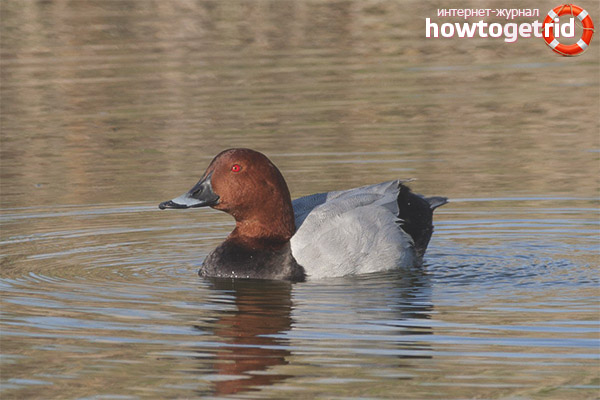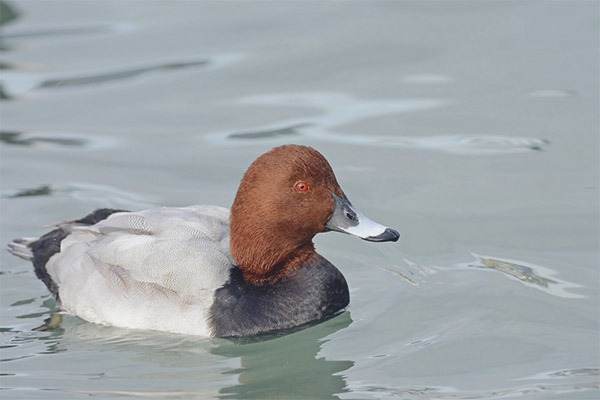The content of the article
Such a migratory, waterfowl as a red-headed dive belongs to the family of ducks, the order of Anseriformes. This type of bird also has nicknames known to many - the Sivash or Krasnobash, which, in fact, are reflected by the peculiarities of the original and bright coloring of the plumage of its representatives.
Appearance, features
The body size of an adult individual of birds of this species is about 58-60 cm, body weight is up to 1.1 kg, wingspan is up to 83 cm. The Sivash Duck is more modest than an ordinary Mallard, a dense, rather large body with a short neck and tail. The characteristic feature of the bird during its standing is too far back legs, which makes it seem like the dive is bending down. The bird's beak is rather long and large, in its size it is not inferior to the head, has a slight extension in the upper part.The diving tail consists of 14 tail feathers. All the plumage of birds of this species is characterized by characteristic blurry patterns of grayish color.
The mating dress of the male dive has significant differences from the main one. The head of the individual has a darker color — brown-red. The back closer to the tail is dark, the tail itself is black with a glossy sheen. The back and sides of the bird have a lighter color - ashen. The black beak has a bluish outflow, the legs of the bird are gray.
Habitats
Red-headed diving most often open shallow water bodies surrounded by reed beds as their habitat. During migration, they often stop at sea bays and lake reaches. Try to avoid ponds with brackish water and sparse vegetation. Quite often this bird of the order of anseriformes chooses old quarries with overgrown shores, reservoirs, marshland and small rivers with a steady flow of water for its habitat. This species of birds inhabits most of Eurasia, Central Asia. In the winter area of the colony, diving is carried out to fly to southern Europe, East Asia and North Africa.
Bird behavior
Often the red-headed dive can be seen in the so-called mixed flocks that make up several species of birds of the family duck. As a rule, in the event of any danger, they are not in a hurry to rise in the air. For these birds, it is more preferable in this case to immerse in water, which helps to quickly escape from pursuit. This is explained by the fact that in order to take off from the surface of the ground, diving requires that sufficient effort be made to push off, after which active work by the wings. In the water, he feels more confident (he swims and dives very well), and quickly moves away from the enemy, at the same time, emitting a lot of noise due to sharp wings of his wings.
Landing on the surface of the water at dives is quite deep - almost the entire tail of the bird sinks.Individuals of this species move overland rather clumsily, a characteristic feature of which is the strongly protruded breast of the bird. Diving makes a hoarse, slightly croaky sound. It should be borne in mind that during the period of molting a duck of a redbred duck undergoes a change in the wing feathering of the wings, respectively, during this period of time they are not able to fly. Often, this time the bird waits in remote and inaccessible places, stumbling into small groups.
Breeding

The bird breeding season lasts from early April to June. As a rule, representatives of this species of ducks form pairs during the flight from the wintering place to the nesting site. During mating games, the males are trying with all their might to attract the attention of the chosen female. For this, the male circles around the female on the surface of the water, deeply lowering the beak into the water and making hoarse, not too loud sounds and whistling.
After pairing and mating of birds, the male, as a rule, is constantly near the nest, but practically does not take part in the care of the offspring.Most often the nest is built by birds in thickets of dense vegetation on the shore of a reservoir. Immediately the nest of birds of this species is a small depression in the ground, framed by dry vegetation and lined with duck down. Medium size - up to 40 cm in diameter.
Sometimes the red-headed dive builds a nest deeper, while it is located directly in the water, such floating construction keeps on the surface at the expense of reed rhizomes. The first laying of eggs can sometimes be carried out by a duck directly into the water or a nest saturated with moisture.
The average number of eggs in one clutch is from 6 to 12 pcs. Eggs are large, regular shape, bluish, with not a pronounced greenish tint. Hatching future offspring lasts about a month. Sometimes the female can throw up her eggs in the nests of other representatives of the species that incubate their offspring. For the next 8 weeks the hatched diving chicks remain close to the female.
It should be noted that, since the red-headed pochard leads a migratory way of life, accordingly, the bird has clearly defined seasonality for breeding.
After prokleva chicks already after a short time begin to swim. Already in the first few days, young diving individuals show enviable activity and independence: they dive, keep well on the water, try to eat independently. As a rule, do not sail away from the nest. Almost complete plumage of chicks occurs after three weeks after spitting. Ability to fly appears on the 50-55 day.
Already at the end of the summer, the young individuals are ready for the flight, this is manifested by the fact that the birds gather in small groups, which will fly to the wintering place.
Diving Power Features
This species of birds of the duck family feeds on a wide variety of food, consuming almost everything that comes along the path of the dive both on land and in water. Nevertheless, the representatives of this species have their own preferences in the consumed diet, such food may include char algae, some buds of aquatic plants, duckweed, elodea, as well as the roots and seeds of various plants. During diving, the duck as food produces worms, larvae of aquatic insects, crustaceans, mollusks.The main time for eating the redhead dive is morning and evening.
During diving the red-headed dive, as a rule, disappears in the water for quite a long time (up to 20 sec). The main feature is that the bird dives under the water, strongly pushing off from the water surface with his feet. For feeding, representatives choose reservoirs with clean water. The depth of diving in an adult is up to 3.5 m. Birds love to splash in shallow water.
At the end of the summer, the young dive chicks begin to eat chironomid. With the onset of autumn and the first cold weather, the main food of young birds on the ponds with brackish water are the stems, as well as such typical vegetation for the area as quinoa and salaros.
Kind and man
Such a migratory waterfowl, like the redbush, is of rather great importance for a person as an object for sporting and commercial hunting. This is especially common in such a region of our country as Western Siberia and in Kazakhstan.
Also of interest to humans is the red-headed dive and as an object for obtaining aesthetic pleasure.The behavior of this bird causes considerable interest among observers, it is distinguished by bright and eye-catching plumage.
The average duration of representatives of this species of ducks in captivity is about two decades.
Today, one of the most popular destinations is sporting events with the participation of birds of this species. Due to its unique colorful and behavioral features, the red-headed dive is a desirable bird for keeping in city water bodies and park zones.
Video: Red-headed Pochhead (Aythya ferina)












To send